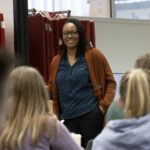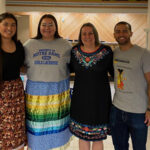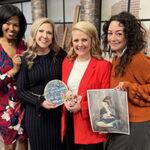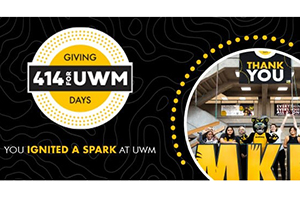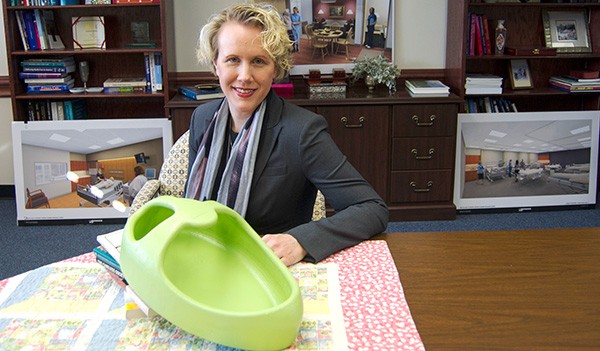
Parents and infants commonly share a bed in some communities, but that can present risks. In Milwaukee alone, about a dozen infants die each year from unsafe sleeping conditions, including suffocation from soft objects such as pillows.
Jennifer Doering, an associate professor of nursing at UWM, became interested in the problem while researching postpartum depression and parental sleep deprivation in impoverished areas. She found a desire for closeness and simple exhaustion led many parents to sleep with their babies.
“Women in my research studies would come to me afterwards and say, ‘I’m going to sleep with my baby no matter what you say. Do you have any advice for me to do it more safely?’”
–Jennifer Doering
To help protect infants, she developed the “Night Owl Sleeper,” an oval-shaped pod that sounds an alarm if bedding falls on it or an adult rolls over. We talked to her about efforts to bring the product to market.
What inspired you to create the pod?
Originally, the idea came from my work with mothers in vulnerable situations.
Women in my research studies would come to me afterwards and say, “I’m going to sleep with my baby no matter what you say. Do you have any advice for me to do it more safely?”
Since I had many parents coming to me repeating the same question, I started thinking about what I could do about this.
How does the pod work?
It works in several ways, but the main thing is that it keeps parents from rolling on their babies from any direction. This product is different from anything else on the market because of this added protection — we call it a bridge — above the baby’s head. By covering the space above the baby’s face and torso in addition to the space around the baby, you can then keep pillows and blankets up off the baby’s face.
Parents also like the fact that the pod actually contains the baby. Many parents who sleep with their babies worry about the baby rolling or falling off the bed and getting injured. This product keeps the baby contained in their own separate space from the parent, yet they are still close together.
Have you had pushback from public health officials who say, “no co-sleeping ever?”
I’ve spoken with people on all ends of the spectrum — from parents who are adamant about sleeping with their baby and believe it’s perfectly safe to directors of SIDS programs who believe nothing can make it safe to sleep with a baby. An administrator of a children’s product safety group looked at the Sleeper and said: “absolutely your product is not the problem; it’s the bed that confers the risk, not your product.”
The people who are sending a singular message about never-ever sleep with your baby have told me that even with (safety) data they will not be convinced. So it’s kind of a Catch-22. If you have data that demonstrates improved safety and people won’t believe the data, then where are you?
It seems in this debate that there are not a lot of people who are willing to admit a more moderate position. At the same time, I talk with a lot of nurses and physicians and public health workers who say it’s exactly what’s needed.
Aren’t there other portable sleeping products for babies on the market?
Some of the products that are really quite intriguing are actually not available in the United States. There are about eight products that you can buy today at Wal-Mart or Target or Babies ‘R Us, but they all have significant limitations. And, not all those products actually contain the baby. I’ve had parents tell me that their babies have wiggled out of them.
The other key difference between our product and other products on the market is the use of technology. Current products on the market focus on monitoring the baby. No products that are sleep-related on the market use technology to help monitor the baby’s environment. Ours is an entirely different approach to detect and prevent problems before other baby monitoring products would ever see them.
If a pillow falls on our product, with the technology we can integrate with this, an alarm will go off. At the same time, the bridge keeps the pillow off the baby’s face, giving the parents time to respond, and the baby air to breathe.
Where has the funding come from for this product?
We started with a Catalyst grant from the UWM Research Foundation. Last fall, we won an Ideadvance Seed grant from UW Extension. We are currently among 54 semi-finalists in the 12th annual Governor’s Business Plan contest, and that could generate exposure and funding.
How soon do you think the pod will be available?
That depends a lot on funding. If we get more funding sooner, it could be in the next year. We definitely see having the product available on our own website sooner rather than later. Having it in stores will be a longer timeline, 18 months to two years out.
